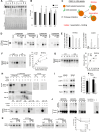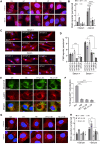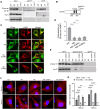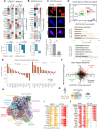Mutant glucocerebrosidase impairs α-synuclein degradation by blockade of chaperone-mediated autophagy
- PMID: 35138901
- PMCID: PMC11809618
- DOI: 10.1126/sciadv.abm6393
Mutant glucocerebrosidase impairs α-synuclein degradation by blockade of chaperone-mediated autophagy
Abstract
The most common genetic risk factors for Parkinson's disease (PD) are a set of heterozygous mutant (MT) alleles of the GBA1 gene that encodes β-glucocerebrosidase (GCase), an enzyme normally trafficked through the ER/Golgi apparatus to the lysosomal lumen. We found that half of the GCase in lysosomes from postmortem human GBA-PD brains was present on the lysosomal surface and that this mislocalization depends on a pentapeptide motif in GCase used to target cytosolic protein for degradation by chaperone-mediated autophagy (CMA). MT GCase at the lysosomal surface inhibits CMA, causing accumulation of CMA substrates including α-synuclein. Single-cell transcriptional analysis and proteomics of brains from GBA-PD patients confirmed reduced CMA activity and proteome changes comparable to those in CMA-deficient mouse brain. Loss of the MT GCase CMA motif rescued primary substantia nigra dopaminergic neurons from MT GCase-induced neuronal death. We conclude that MT GBA1 alleles block CMA function and produce α-synuclein accumulation.
Figures








Similar articles
-
Autophagic lysosome reformation dysfunction in glucocerebrosidase deficient cells: relevance to Parkinson disease.Hum Mol Genet. 2016 Aug 15;25(16):3432-3445. doi: 10.1093/hmg/ddw185. Epub 2016 Jul 4. Hum Mol Genet. 2016. PMID: 27378698 Free PMC article.
-
Glucocerebrosidase gene therapy prevents α-synucleinopathy of midbrain dopamine neurons.Neurobiol Dis. 2015 Oct;82:495-503. doi: 10.1016/j.nbd.2015.09.009. Epub 2015 Sep 25. Neurobiol Dis. 2015. PMID: 26392287
-
The relationship between glucocerebrosidase mutations and Parkinson disease.J Neurochem. 2016 Oct;139 Suppl 1(Suppl Suppl 1):77-90. doi: 10.1111/jnc.13385. Epub 2016 Feb 10. J Neurochem. 2016. PMID: 26860875 Free PMC article. Review.
-
Acid ceramidase inhibition ameliorates α-synuclein accumulation upon loss of GBA1 function.Hum Mol Genet. 2018 Jun 1;27(11):1972-1988. doi: 10.1093/hmg/ddy105. Hum Mol Genet. 2018. PMID: 29579237 Free PMC article.
-
The lysosomal β-glucocerebrosidase strikes mitochondria: implications for Parkinson's therapeutics.Brain. 2024 Aug 1;147(8):2610-2620. doi: 10.1093/brain/awae070. Brain. 2024. PMID: 38437875 Review.
Cited by
-
ACO2 deficiency increases vulnerability to Parkinson's disease via dysregulating mitochondrial function and histone acetylation-mediated transcription of autophagy genes.Commun Biol. 2023 Nov 25;6(1):1201. doi: 10.1038/s42003-023-05570-y. Commun Biol. 2023. PMID: 38007539 Free PMC article.
-
Selective dopaminergic vulnerability in Parkinson's disease: new insights into the role of DAT.Front Neurosci. 2023 Aug 24;17:1219441. doi: 10.3389/fnins.2023.1219441. eCollection 2023. Front Neurosci. 2023. PMID: 37694119 Free PMC article. Review.
-
Novel therapeutic targets to halt the progression of Parkinson's disease: an in-depth review on molecular signalling cascades.3 Biotech. 2023 Jul;13(7):218. doi: 10.1007/s13205-023-03637-5. Epub 2023 May 30. 3 Biotech. 2023. PMID: 37265542 Free PMC article. Review.
-
Study protocol of the GRoningen early-PD Ambroxol treatment (GREAT) trial: a randomized, double-blind, placebo-controlled, single center trial with ambroxol in Parkinson patients with a GBA mutation.BMC Neurol. 2024 May 1;24(1):146. doi: 10.1186/s12883-024-03629-9. BMC Neurol. 2024. PMID: 38693511 Free PMC article.
-
GBA Variants and Parkinson Disease: Mechanisms and Treatments.Cells. 2022 Apr 8;11(8):1261. doi: 10.3390/cells11081261. Cells. 2022. PMID: 35455941 Free PMC article. Review.
References
-
- Cuervo A. M., Stefanis L., Fredenburg R., Lansbury P. T., Sulzer D., Impaired degradation of mutant alpha-synuclein by chaperone-mediated autophagy. Science 305, 1292–1295 (2004). - PubMed
-
- Tang F. L., Erion J. R., Tian Y., Liu W., Yin D. M., Ye J., Tang B., Mei L., Xiong W. C., VPS35 in dopamine neurons is required for endosome-to-golgi retrieval of Lamp2a, a receptor of chaperone-mediated autophagy that is critical for α-synuclein degradation and prevention of pathogenesis of Parkinson’s disease. J. Neurosci. 35, 10613–10628 (2015). - PMC - PubMed
MeSH terms
Substances
Grants and funding
LinkOut - more resources
Full Text Sources
Medical
Molecular Biology Databases
Research Materials

